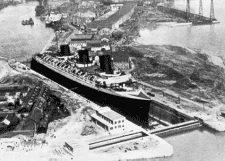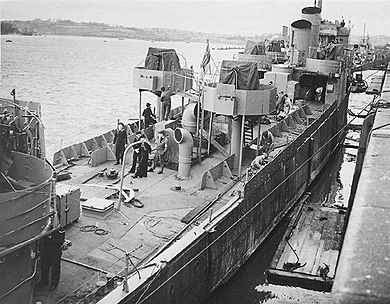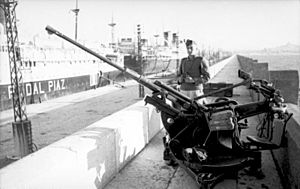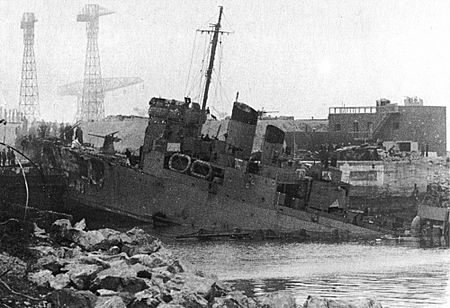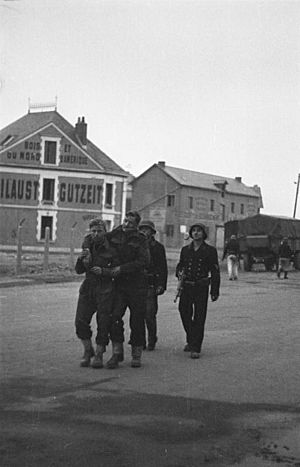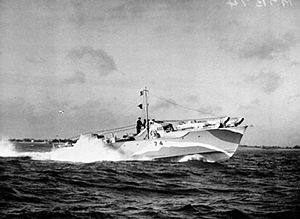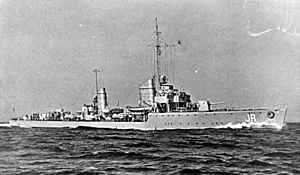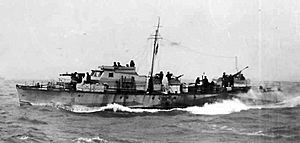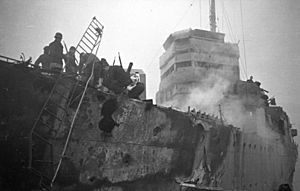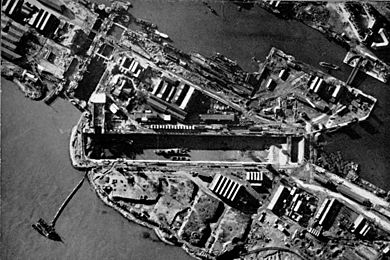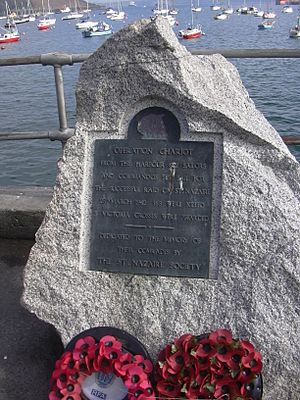St Nazaire Raid facts for kids
Quick facts for kids St Nazaire Raid |
|||||||
|---|---|---|---|---|---|---|---|
| Part of the North West Europe Campaign of World War II | |||||||
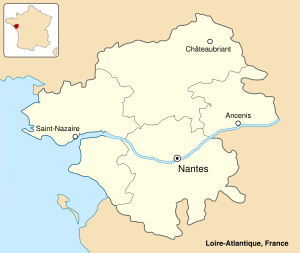 St Nazaire on the Loire estuary |
|||||||
|
|||||||
| Belligerents | |||||||
| Commanders and leaders | |||||||
|
|||||||
| Units involved | |||||||
Selected troops from the Special Service Brigade
|
|
||||||
| Strength | |||||||
|
5,000 troops | ||||||
| Casualties and losses | |||||||
|
|
||||||
|
|||||||
The St Nazaire Raid, also called Operation Chariot, was a daring attack by British forces during World War II. On March 28, 1942, the Royal Navy and British Commandos launched a surprise attack on the heavily guarded Normandie dry dock in St Nazaire, France. At the time, France was occupied by Germany.
The main goal was to destroy this huge dry dock. It was the only one on the Atlantic coast large enough to repair big German warships like the battleship Tirpitz. If the dock was out of action, any damaged German warship would have to sail all the way back to Germany. This journey would be very dangerous, as it meant passing through areas controlled by the British Navy.
For the raid, an old destroyer named HMS Campbeltown was packed with hidden explosives. It was then crashed into the dock's main gate. Later that day, the explosives blew up, completely destroying the dock. It remained unusable until 1948, long after the war ended.
While the ship crashed, British Commandos landed to destroy other important machinery and buildings. German forces fought back fiercely, sinking or damaging most of the small boats meant to take the Commandos back to England. The Commandos had to fight their way through the town, but many were captured when they ran out of ammunition.
Out of 612 British soldiers and sailors who took part, 228 made it back to Britain. Sadly, 169 were killed, and 215 became prisoners of war. The Germans lost over 360 people, including some civilians caught in the explosion. Many brave individuals received awards for their actions, including five Victoria Crosses, Britain's highest military honor.
Contents
Why Attack St Nazaire?
St Nazaire is a port city in France, located on the north bank of the Loire River. In 1942, it was a busy port with a population of 50,000 people. The port had a large outer harbor and two inner docks. The most important part was the Normandie dry dock. This massive dock was built to hold the huge ocean liner SS Normandie. When it was finished in 1932, it was the biggest dry dock in the world.
In 1941, the German battleship Bismarck was damaged in a battle. It tried to reach St Nazaire for repairs because it was the only port on the Atlantic coast that could handle a ship of its size. However, the Bismarck was sunk before it could get there.
Later, in 1942, another powerful German battleship, the Tirpitz, became ready for action. British military leaders worried that if the Tirpitz entered the Atlantic Ocean, it could cause huge problems for Allied shipping. They knew that if the Tirpitz ever needed repairs, St Nazaire was its only option on the Atlantic coast. So, they decided that if the Normandie dock was destroyed, the Germans would not risk sending the Tirpitz into the Atlantic.
Planning the Raid
British planners looked at different ways to destroy the dock. Bombing by the Royal Air Force (RAF) was ruled out because their bombs were not accurate enough. They didn't want to cause too many civilian deaths. The Special Operations Executive (SOE), a secret British organization, also said the mission was too big for them. The Royal Navy couldn't send large ships up the river without being spotted.
So, they decided a commando raid was the best option. They realized that a very high tide in March 1942 would allow a light ship to pass over sandbanks in the river. This meant they could approach the docks without using the heavily defended main channel.
The Daring Plan
The main idea was to use a specially prepared destroyer packed with explosives. This ship would ram into the main dock gates. Commandos on board would then jump off and use their own explosives to destroy nearby buildings, searchlights, and gun positions. The destroyer would then explode, making sure the dock was completely unusable. The RAF would also fly diversionary bombing raids to distract the Germans.
At first, the British Navy didn't like the idea of losing a destroyer. But they agreed to provide an old ship and smaller boats to carry the Commandos. The mission was given the code name Operation Chariot.
British intelligence agencies worked together to plan every detail. They gathered maps of St Nazaire, information on German coastal guns, and details about the dock itself. They even used secret messages decoded from the German Enigma machine to plan the best route and timing. The whole raid was expected to last only two hours.
The Raiding Force
The Royal Navy provided most of the forces for the raid, led by Commander Robert Ryder. The ship chosen to ram the dock gates was HMS Campbeltown. This was an old destroyer from World War I that the United States had given to Britain.
Campbeltown was changed a lot for the mission. To make her lighter and able to cross the sandbanks, all her inside compartments were emptied. Her main guns were removed, and smaller, faster-firing guns were added. The bridge was given extra armor. Two of her four funnels were removed, and the remaining two were cut at an angle to make her look like a German ship. Most importantly, her bow (front) was packed with 4.5 tons of powerful explosives, set to explode after the raiders had left.
Other naval ships included two destroyers, HMS Tynedale and Atherstone, which would stay out at sea. A Motor Gun Boat (MGB 314) was the main command ship, carrying Commander Ryder and the Commando leader, Lieutenant-Colonel A. C. Newman. A Motor Torpedo Boat (MTB 74) was also part of the plan. It would torpedo the inner dock gates if the main ones were open, or other gates if they were closed.
Twelve Motor Launches (MLs) were used to carry the Commandos. These small boats were armed with machine guns and cannons. Four more MLs were added later, armed with torpedoes to attack any German ships. A British submarine, HMS Sturgeon, would act as a navigation beacon to guide the convoy into the river.
The Commando force was led by Lieutenant Colonel Augustus Charles Newman. Most of the Commandos were from No. 2 Commando, but others came from different Commando units. They were divided into three groups, each with specific tasks:
- Group One would land at the Old Mole jetty, destroy anti-aircraft guns, and blow up the power station and bridges.
- Group Two would land at the old entrance to the basin, destroy anti-aircraft guns, attack the German headquarters, and guard against counterattacks.
- Group Three would be on Campbeltown and would destroy the dock's water pumps and fuel tanks.
Each group had assault teams to clear the way, demolition teams with explosives, and protection teams to defend them.
German Defenses
The Germans had about 5,000 troops defending St Nazaire. The port was protected by many guns, from small 20mm anti-aircraft guns to huge 280mm railway guns. Many of these guns were in concrete bunkers on top of the submarine pens.
The German Navy also had several ships in the area, including a destroyer, an armed trawler, and minesweepers. Two German U-boat flotillas were based in the port, but it's not known how many submarines were there on the day of the raid. Just before the raid, the U-boat Commander in Chief had visited the base. He was told that an attack by British Commandos was "highly improbable."
The Raid Begins
The British ships left Falmouth, England, at 2:00 PM on March 26, 1942. They sailed in a convoy, sinking two French fishing trawlers they met along the way to keep their mission secret. As they got closer to St Nazaire, two more British destroyers joined them for the return journey.
At 9:00 PM, the convoy changed course towards the Loire estuary. Campbeltown raised a German naval flag to trick any lookouts. The submarine Sturgeon used its navigation beacon to guide them in.
At 11:30 PM on March 27, 35 British bombers started their diversionary raids over St Nazaire. They were ordered to bomb only clearly identified military targets and drop one bomb at a time. Bad weather meant only a few planes actually bombed targets in St Nazaire. This unusual bombing made the German commander suspicious. He ordered all guns to stop firing and searchlights to be turned off, thinking the bombers might be using them to find the port. Everyone was put on high alert.
At 2:00 AM, a German submarine spotted the convoy but reported them moving in the wrong direction, adding to the German confusion.
Ramming the Dry Dock
At 12:30 AM on March 28, the convoy crossed the shallow sandbanks at the mouth of the Loire estuary. Campbeltown scraped the bottom twice but broke free. They were only about eight minutes from the dock gates when, at 1:22 AM, powerful searchlights lit up the entire convoy. A German signal light demanded their identification.
MGB 314 replied with a secret German code they had captured earlier. A few shots were fired from shore, and Campbeltown and MGB 314 replied, "Ship being fired upon by friendly forces." This trick bought them a little more time before every German gun in the bay opened fire.
At 1:28 AM, with the convoy just one mile from the dock gates, Campbeltown's captain, Lieutenant Commander Beattie, ordered the German flag lowered and the British flag raised. The German gunfire became even more intense. Campbeltown was hit many times, but she sped up to 19 knots. Her helmsman was killed, and his replacement was wounded.
Blinded by searchlights, Beattie knew they were close. Still under heavy fire, Campbeltown cleared the end of the Old Mole, cut through anti-torpedo nets, and slammed into the dock gates at 1:34 AM. The impact drove the ship 33 feet into the gates, crushing the front part of the bow where the explosives were hidden.
Commandos Land and Fight
The Commandos on Campbeltown immediately jumped off. Their mission was to destroy the dock's pumping machinery and other important installations. Captain Donald Roy and his team bravely attacked two gun positions on the roof of a pump-house, using ladders and grenades. They also secured a bridge, allowing other demolition teams to move forward.
Many of the small MLs carrying other Commando groups were destroyed or set on fire during the approach. Only ML 457 managed to land its Commandos on the Old Mole, and ML 177 reached the gates at the old entrance to the basin. That team successfully placed explosives on two tugboats.
Lieutenant Colonel Newman, the Commando leader, was one of the first ashore. He directed mortar fire onto a German gun position that was causing many casualties. He also ordered machine-gun fire onto an armed German trawler, forcing it to retreat. Newman organized a defense that held back German reinforcements while the demolition teams finished their work.
With most of the small boats destroyed, Newman realized that escaping by sea was impossible. He gathered the remaining 100 Commandos and gave them three orders:
- Try their best to get back to England.
- Not surrender until all their ammunition was gone.
- Not surrender at all if they could help it.
Newman and his second-in-command, Major William Copland, led the Commandos through the town. They tried to reach the countryside, but German forces surrounded them. When they ran out of ammunition, they surrendered. However, five Commandos managed to escape through neutral Spain and eventually returned to England.
The Small Boats' Brave Fight
Most of the wooden MLs were destroyed or burning during the approach. Many crews fought bravely. ML 447 got very close to the mole despite heavy fire and grenades before being set on fire. Its crew was rescued by ML 160, which was looking for targets like the two large tankers in the harbor. The commanders of ML 160 and ML 447 were awarded medals for their bravery.
Wireless operator Thomas O'Leary on ML 446 described the intense German fire: "One commando was remarking how pretty the tracer fire, red and green, was. A moment later one blew the back of his head out."
ML 177, which had rescued some of Campbeltown's crew, was sunk on its way out of the river. ML 269, a torpedo-armed boat, sped up and down the river to draw German fire away from the landings. It was hit, its steering damaged, and its engine caught fire.
ML 306 also faced heavy fire. Sergeant Thomas Durrant of No. 1 Commando, manning a machine gun, kept firing at German positions even after being wounded. He continued to fight until the ML was boarded by the German torpedo boat Jaguar. Durrant died of his wounds and was awarded a Victoria Cross after his death, even recommended by the German commander.
After the Commandos landed, Commander Ryder checked that Campbeltown was firmly stuck. He then ordered the MTB to torpedo the lock gates at the old entrance to the basin. After a successful attack, the MTB left, picking up survivors from a sinking ML before being hit and set on fire itself.
Back at the docks, the MGB positioned itself in the middle of the river to fire at enemy gun positions. Able Seaman William Alfred Savage bravely manned the forward gun. Commander Ryder noted that the Commandos had overcome resistance, and German fire was slowing down.
Ryder saw only burning MLs and realized the landing places were recaptured by the Germans. There was nothing more they could do for the Commandos, so they headed out to sea. They were constantly targeted by German searchlights and guns. About four miles offshore, the last German shots hit them, killing Savage, who was still at his gun. He was also awarded a Victoria Cross after his death for his incredible bravery.
The Journey Home
At 6:30 AM, the British destroyers Atherstone and Tynedale spotted five German torpedo boats. They exchanged fire, and the German boats turned away. The destroyers then found the MGB and two MLs, transferring their wounded to Atherstone before heading home.
Later, more British escort destroyers arrived. German aircraft, including a Heinkel 115 and a Junkers 88, spotted the ships. A British Bristol Beaufighter fought the Junkers 88, and both planes crashed into the sea. Other German planes were driven off by British aircraft. As the weather worsened, the damaged small ships couldn't keep up. Their crews were taken off, and the boats were sunk.
However, ML 160, ML 307, and ML 443 reached the meeting point and waited. They were attacked by German planes but managed to shoot one down. They eventually reached England on their own the next day.
The Explosion of Campbeltown
The explosives in HMS Campbeltown finally blew up at noon on March 28, 1942. The dry dock was completely destroyed. Reports say that two tankers inside the dock were either swept away and sunk or pushed to the far end of the dock.
A group of 40 senior German officers and civilians were touring Campbeltown when it exploded. They were all killed. In total, the explosion killed about 360 people. The wreck of Campbeltown could still be seen in the dry dock months later in aerial photographs.
According to Captain Robert Montgomery, a Commando officer, Campbeltown was supposed to explode earlier. He believed the delay was due to a problem with the detonators. He recalled that just before the explosion, Captain Beattie was being questioned by a German officer who said the damage wouldn't take long to fix. At that moment, Campbeltown exploded. Beattie smiled and said, "We're not quite as foolish as you think!"
Two days later, on March 30, the torpedoes from MTB 74, which had a delayed fuse, also exploded at the old entrance to the basin. This caused panic among the Germans. Workers from the Organisation Todt (a German engineering group) ran away. German guards, mistaking their uniforms for British ones, opened fire, killing some of them. The Germans also thought Commandos were still hiding in the town, leading to a street-by-street search where some townspeople were also killed.
What Happened Next?
The St Nazaire Raid was a success because the dry dock was put out of action for the rest of the war. However, it came at a high cost. Out of 612 British sailors and Commandos, only 228 returned to England. Five Commandos escaped through neutral Spain and Gibraltar. Sadly, 169 men were killed, and 215 became prisoners of war. The fallen British raiders were buried in a cemetery near St Nazaire.
To recognize their bravery, 89 awards were given for the raid. This included five Victoria Crosses, awarded to Lieutenant Commander Beattie, Lieutenant Colonel Newman, Commander Ryder, and posthumously to Sergeant Durrant and Able Seaman Savage. Many other medals were also awarded.
Adolf Hitler was very angry that the British had been able to sail ships up the Loire River without being stopped. He fired a top German general. The raid made Germany focus more on strengthening their coastal defenses, known as the Atlantic Wall. They started building many more concrete bunkers and gun positions.
The battleship Tirpitz never entered the Atlantic Ocean. It remained hidden in Norwegian fjords, threatening Allied shipping, until it was finally destroyed by the RAF in 1944.
Legacy of the Raid
St Nazaire was one of 38 battle honours given to the Commandos after the war. The survivors of the raid formed their own group, the St Nazaire Society.
A memorial in Falmouth, England, honors the raid with this inscription: "In memory of the Royal Navy Sailors and Army Commandos killed in the raid on St Nazaire on 28 March 1942."
A new British warship, HMS Campbeltown, a Type 22 frigate, was launched in 1987. It carried the ship's bell from the original Campbeltown. This bell had been saved during the raid and given to the town of Campbelltown, Pennsylvania, after World War II. The people of Campbelltown lent the bell to the new ship. The bell was returned to the town in 2011 when the new HMS Campbeltown was taken out of service.
On September 4, 2002, a tree and a seat were dedicated at the National Memorial Arboretum to the men of the raid. The seat's inscription reads: "In memory of the Royal Navy Sailors and Army Commandos killed in the raid on St Nazaire on 28 March 1942."
Another new ship, a Type 31 frigate named HMS Campbeltown, was announced in 2021 for the Royal Navy.
See also
- Bill Etches
- Gift Horse (film)
- Attack on the Iron Coast (film)
- Donald William Roy
- Medal of Honor: European Assault (game)


